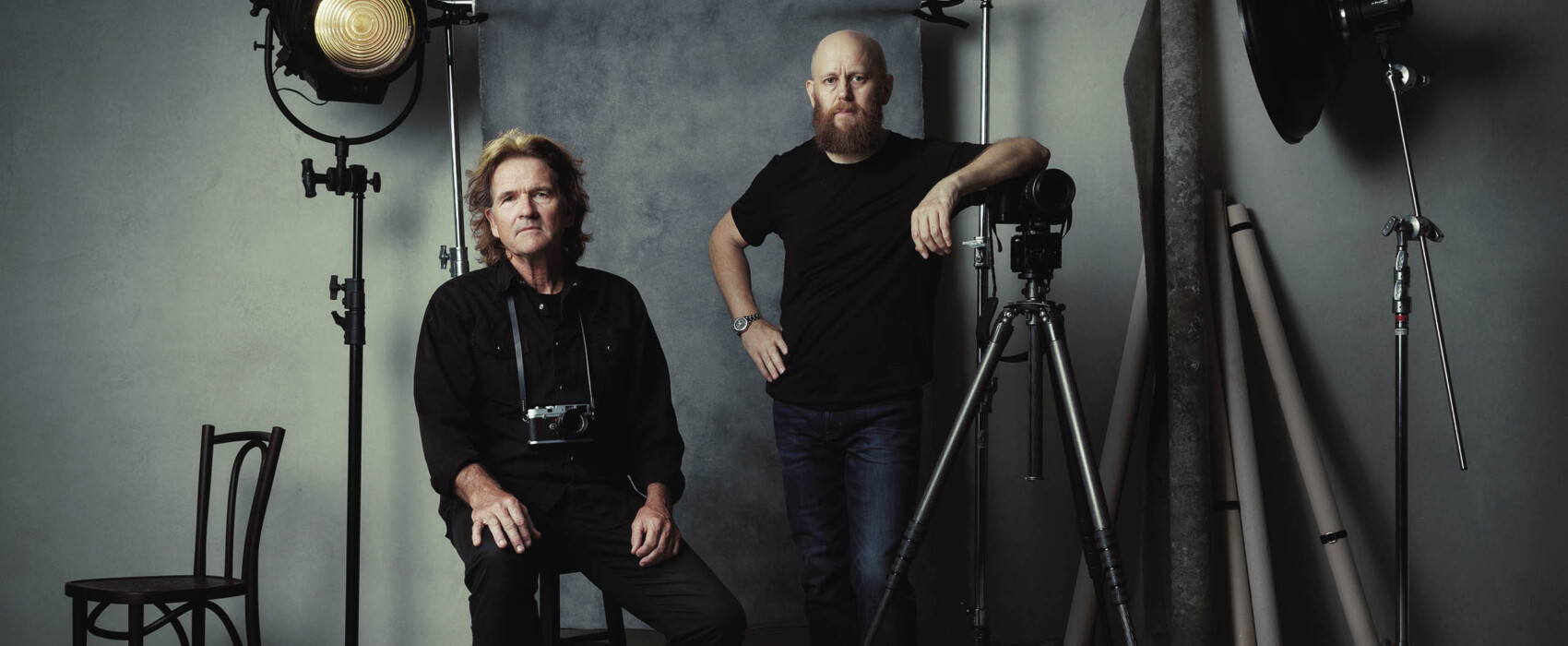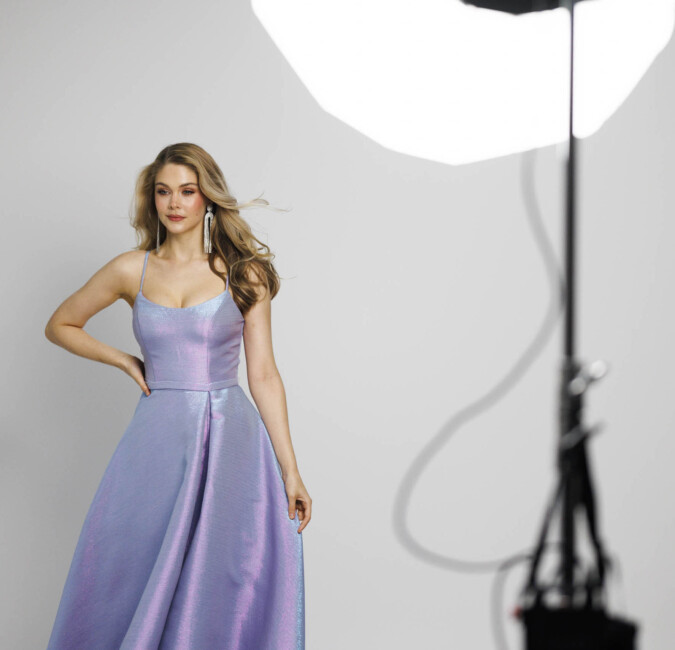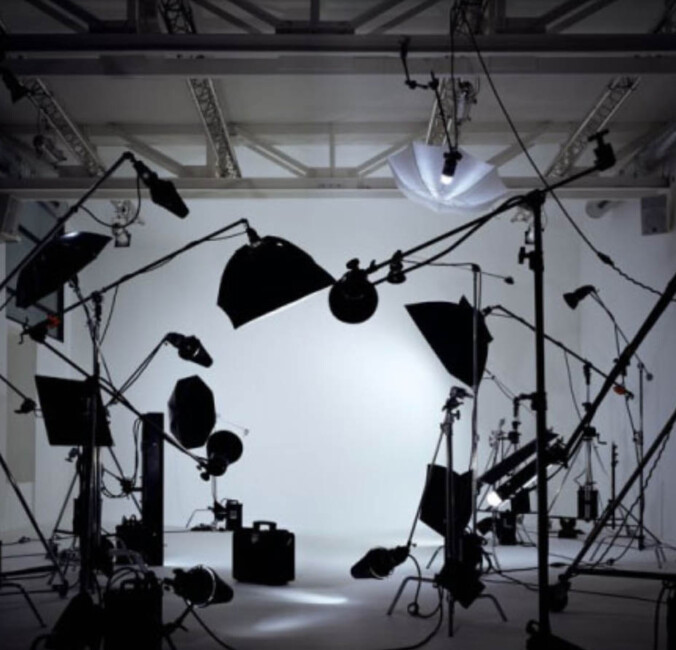Brisbane Portrait Photographers Glenn Hunt and Russell Shakespeare at Blacklight Studios
Brisbane Portrait Photographers Glenn Hunt and Russell Shakespeare at Blacklight Studios for an interview about the introduction of AI into the Brisbane Portrait Prize.
Writer: Jamie Walker
Award-winning photographers Glenn Hunt and Russell Shakespeare are by necessity early adopters of new technology. It’s the name of the game they’re in.
But when the prestigious Brisbane Portrait Prize announced this year’s competition would be open to entries wholly generated by artificial intelligence it was a leap into the unknown they weren’t willing to take.
Hunt, the 2020 winner of the awards’ digital section, said he wouldn’t enter again, followed by his friend, Shakespeare, the category’s 2021 titleholder. Other prominent past participants piled in, warning that if they had to go up against AI the organisers could keep the $90,000 in prize money.
It wasn’t art and it wasn’t fair.
Yet it is also the way of an increasingly digitalised world, where smart machines are intruding on more and more aspects of daily life. Can art really stand apart? If not, where does human creativity end and a computer take over?
“They’re good questions,” said Anna Reynolds, the founding chair of the Brisbane Portrait Prize whose board this week walked back its position on AI after the boycott launched by the two photographers gained traction.
“Russell and Glenn are both fabulous artists and we really appreciated their input. I think what’s happening here is a bit of a microcosm of the broader art world in terms of how we’re trying to deal with AI.
“We tried to take a reasonable, middle-ground approach to where we are at the moment … but you’re never going to make everybody happy, right? Having said that, I do accept that the terms of entry weren’t very well drafted. We did the sensible thing and changed them.”
Reynolds’ response reflects the complexity of the issue. Entrants in the digital category – the only section affected, she insisted – would still be allowed to use some AI provided they declared this to the judges. But entirely AI-generated work were out, along with any entry produced by imaging platforms Midjourney and DALL-E due to copyright concerns.
“What we’re saying is that it’s quite clear that digital editing in the digital category is a part of creating the artwork,” she told The Weekend Australian. “But … where you’re using a computer program based on other people’s work that is not OK. The reason it’s not OK is that one of the clear terms in all categories is that every entry has to be the artist’s own work.”
Hunt and Shakespeare remain unconvinced. Each has a storied press pedigree, including with this masthead, straddling the decadeslong transition of newspaper photography from the darkroom days of film to motor-driven electronic cameras and the digital revolution fired by the Internet.
Hunt, 51, collected the portrait prize’s digital award four years ago with a “slightly tweaked” photo of boxer Jeff Horn, first published in The Australian.
Shakespeare, 60, has a sought-after Walkley award to his credit, and is a four-time finalist in the portrait prize. Ironically, Hunt talked him into entering his winning study of Indigenous artist Judy Watson in 2021 after Shakespeare initially baulked, believing his friend had it in the bag with a moody photograph of the unjustly detained foreign correspondent, Peter Greste.
But until AI is banned or, at a minimum, consigned to its own category in the competition, they will sit it out. “When Russell told me about the new rules I couldn’t believe it,” Hunt said. “The bit that got most people’s noses out of joint is the creative part … the idea that something created wholly by AI can be art is just nonsensical. Because how does that create the connection you’re supposed to make in the portrait with the subject, with Brisbane?
“And, in general, none of us want to compete against computers. It’s not what art is for. Art is supposed to be about and for humans.”
Shakespeare agreed. “Look, AI has been with us for a while in photography, in many different forms, particularly Photoshop,” he said, referring to the popular digital tool developed by software giant Adobe.
“But with Photoshop you’re dealing with images that Adobe has copyright to. The latest AIs, Midjourney and DALL-E, are a different kettle of fish. They basically scrape photographs and artworks off the Internet, and I have a problem with that – it’s other people’s work. I don’t think it should be condoned by something like a big arts prize.
“If you are going to have it, my feeling is you need a separate category. It’s like drugs in sport … if people are going to dope they shouldn’t be allowed to compete with the rest of the athletes.”
Other competitions are grappling with the AI conundrum. The National Portrait Gallery’s National Photographic Portrait Prize this year allowed the use of generative AI tools in photographic entries, but in a similar vein to Brisbane won’t accept wholly AI-created images.
“Photography is a medium that has been radically transformed by technological developments since its inception, and the introduction of generative AI tools is an extension of this history,” said the gallery’s director, Bree Pickering.
But the nation’s best known portrait contest, the Art Gallery of NSW’s Archibald Prize, will hold true to a century of tradition and mandate that entries be painted by the hand of the submitting artist.
Overseas, German artist Boris Eldagsen last year pushed the limits when he won the creative open category of the Sony World Photography Award with an undeclared AI-derived image.
Refusing the award, he said he had entered as a “cheeky monkey” to test the judges and stimulate debate about the future of photography. “AI images and photography should not compete with each other in an award like this,” Eldagsen declared.
The literary world has had its problems, too. Last month, Japanese novelist Rie Kudan revealed she had used ChatGP to help write the book that took out the 170-year-old Akutagawa Prize for the best work of fiction by a new writer. About five per cent of The Tokyo Tower of Sympathy, lauded as “practically flawless” by the judges, had been cranked out by the chatbot.
Australia’s premier fiction prize, the Miles Franklin Award, requires that entries “consist entirely of the author’s original work”. The competition’s 2023 winner, Shankari Chandran, said there was no role for AI in creating literature: “There is only the writing, done by human beings for human beings.”
“Whatever the modality of the artist, there is enormous skill and struggle in what artists do,” she said. “They face the metaphorical and actual blank page with the courage of humans, not the clinical data training of AI. This is regardless of the fact that somewhere in the recesses of the creation chain, there was once a human programmer behind the AI.”
An evergreen Tom Keneally, 88, was more accepting of the technology, saying that writers and their audiences would have to learn to live with the “industrial inequity” of AI involvement in the creative process. He cautioned, however: “We’d all feel a bit cheated if it did come into wide use unless this was done with great sophistication.”
Would he go for a literary award open to AI? “I think so,” the Booker and dual Miles Franklin prize-winner said. “The acceptance of AI-generated material would not stop me from entering. But I think I’d be bound to ask the question: what transcendental cleverness went into the instructions?”
Reynolds conceded that the Brisbane Portrait Prize had opened “a bit of a can of worms” with its initial proposal to accept wholly AI-generated images, putting it ahead of the pack in Australia. “The board takes decisions based on what’s important for the prize and the artist, staying true to our charter and our mission rather than how it’s going to play out,” she said.
“We try and listen when people have things to say to us; we try and act in a principled way, which is what’s driving this. It’s not being driven by whether we’ll get headlines or not, it’s being driven by what’s the right thing to do in the current climate.”
She thinks it’s a good idea for the organisers of the big visual arts awards to get together to thrash out a framework to deal with AI. One thing was certain: the issue wasn’t going away, Reynolds said. And there was no point banning it when the “genie was already out of the bottle in that respect.”
But what about the blurring of the line between artistry and artificial intelligence, the point of principle that Hunt and Shakespeare stood up for? “There is no complete answer to that,” Reynolds said.
“I mean, it’s a bit like everything, you hope that humanity will always win out. And we can … put some structures around that to commit to the principle that the artist and the creative process are … the most important thing for the Brisbane Portrait Prize and everything else sort of spins around that.”




